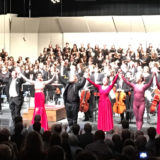By Timothy Gaylard, Special to The Roanoke Times
The Roanoke Symphony’s Masterworks season continued on Sunday afternoon with a program of Mozart, Vaughan Williams and Tchaikovsky conducted by David Stewart Wiley.
A crowd of about 830 people filled Shaftman Hall at Jefferson Center. Featured on the second half of the program was internationally renowned pianist Tanya Gabrielian.
The afternoon began with Mozart’s Symphony No. 36, known as the “Linz.”
At the very outset, Wiley established an elegant yet festive approach. In the slow introduction, the ensemble was tight and dramatic. In the first allegro, the themes were presented like contrasting characters in an opera.
The slow movement drew listeners’ attention to the mellifluous sounds of the orchestra, especially the winds. The classical style is so transparent that a few moments of ragged ensemble were obvious in the last two movements. Still the sturdy minuet proceeded with gusto, and the fast finale sizzled with excitement and energy.
To close off the first half, Vaughan Williams’ very evocative “Fantasia on a Theme by Thomas Tallis” came off effectively with a range of textures and a haunting spiritual atmosphere.
Written for strings only, this work blends various combinations of soloists and sub-ensembles. Here the sweeping melodies shone and the harmonies refracted through a hazy mist of sound. Wiley brought the work to a passionate climax before it subsided to a tranquil ending, capped by Akemi Takayama’s soaring violin solo.
After the intermission, the much anticipated appearance of Gabrielian in Tchaikovsky’s beloved First Piano Concerto proved to be a winning performance.
With the strong pounding chords accompanying the main theme, she established an authority and passion in keeping with the composer’s romantic style.
As the first movement continued into its allegro section, the soloist turned to a various range of colors on her instrument, sometimes warm and lyrical, sometimes brilliant and steely, especially in the virtuosic cadenza.
At the end of that movement, the high-octane level of the performance sparked an enthusiastic and spontaneous ovation from the audience.
In the slow movement, Wiley evinced a tranquil and nostalgic mood, and some solo instruments in the orchestra were featured, especially the ravishing tone of Kelley Mikkelsen’s cello and the gorgeous melancholy of Bill Parrish’s oboe.
Despite a few missed notes, Gabrielian applied a musical and expressive arsenal of techniques to the last movement.
Wiley was ably supportive all the way to a triumphant and exhilarating close, which brought the audience to its feet immediately.
Gabrielian then played as an encore a sparkling and dazzling piano transcription of Glinka’s song “The Lark.”
Timothy Gaylard is professor of music at Washington and Lee University.

